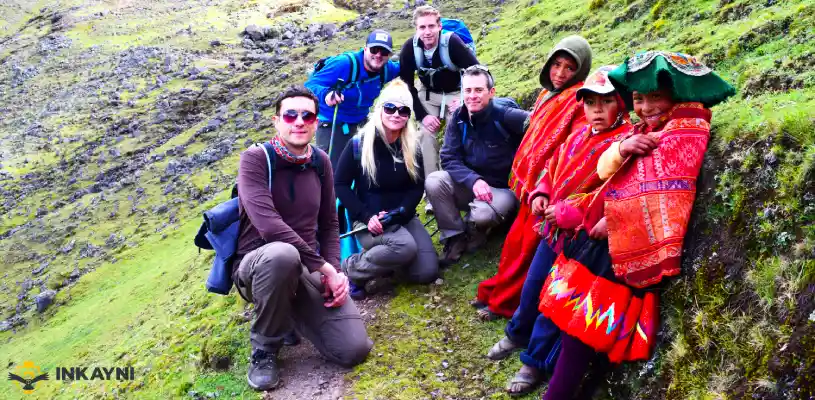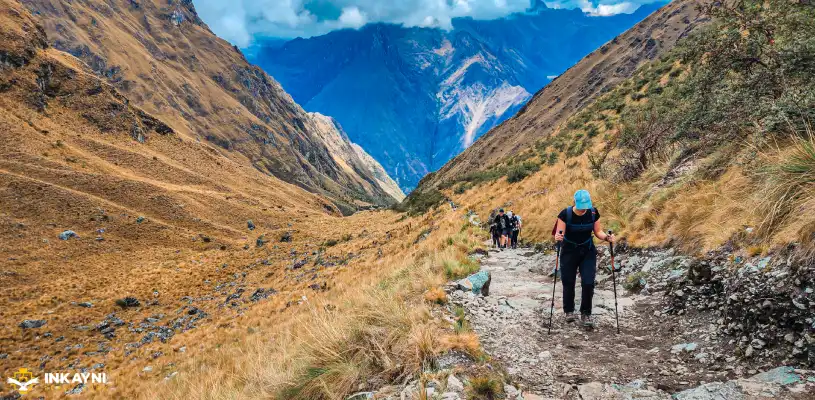Is Ausangate Trek dangerous or an exciting challenge? Find out the answer to this question by reading this blog. Welcome to our exciting blog! This time, we will address the question many travelers ask themselves: is Ausangate Trek dangerous?
Find out everything you need to know about this incredible and fascinating trekking route in the Peruvian Andes and also remove your doubts about its level of danger, safety measures and recommendations to make the most of this wonderful experience.
We are Inkayni Peru Tours, and we have written this and other blogs to immerse you in the natural beauty and adventure which the Ausangate Trek has to offer. Will you dare to accept the challenge and unveil Ausangate’s mysteries? The adventure awaits, don’t miss it!
WHAT IS THE AUSANGATE TREK?
Peru is home to many trekking routes, including the Ausangate Trek. For me, it is one of the most beautiful in Cusco, and even we can even compare it with others in Central Peru. The Ausangate Trek is one of the toughest treks in southern Peru due to its altitude of over 4000 m / 13000 ft ASL and the area you can hike up to your schedule.
Furthermore, the Ausangate Trek emphasizes the trek because there are fewer Inca sites around the area than the Inca Trail, Lares Trek or Choquequirao Trek and doesn’t get to Machu Picchu directly.
The Ausangate Trek name comes from the highest snow-capped mountain which arose thousands of years ago. You will realize that the trek is made on the Ausangate’s foothill.
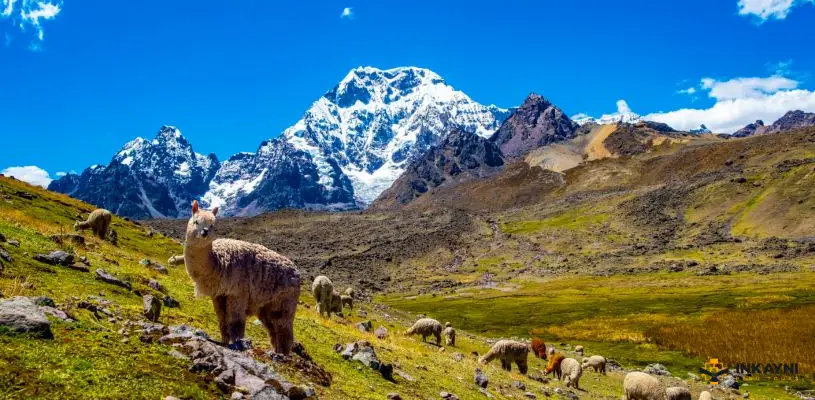
The imposing Ausangate Mountain
AUSANGATE MOUNTAIN OR APU AUSANGATE
Ausangate Mountain is located in the Vilcanota mountain range, and it is the highest peak there at 6384 m / 20940 ft ASL. This huge snow-capped mountain could be seen from Cusco, which is just 100 km / 65 mi northwest!
Nevado Ausangate is not just a common hike accompanied by beautiful natural scenery and highland biodiversity but also one of the most spiritual places in the Andes. Since Inca times, local communities and villages have made offerings to this mountain, the most revered one in the Cusco region. Even these dwellers have been hiking through the Ausangate Trails.

Mammals of the Ausangate area
AUSANGATE TREK SUMMARY
- Total trek distance: 70 km/43 miles approx.
- Duration: 4 – 6 days
- Start/finish point: Tinqui
- Highest points: Arapa Pass – 4,850 m / 16,000 ft; Palomani Pass – 5,165 m / 17,000 ft
- Average altitude: 4,000 m / 13,123 ft
- Elevation gain: 2,867 m / 9,406 ft
- Difficulty: Challenging
- Acclimatization: 2 to 3 days in Cusco are recommended before trekking.
- Weather: Sun, rain, wind, snow and hail.
- Permits: No trekking permit is required.
TREKKING TOWARDS THE AUSANGATE MOUNTAIN
Hiking at high altitude is a challenge, so acclimatization and fitness are needed and hiking experience too.
Some hikers love climbing and others prefer hiking. Everyone is different, so when reading various articles about Ausangate trekking, you should also consider your own abilities and preferences.

Ausangate mountain foothills.
Ausangate trails are above 4,000 m / 13,123 ft. There are not too many steep sections because of the terrain and geography. So, if you have good physical condition and are well acclimated, you shouldn’t have problems enjoying this hike.
As a recommendation, carrying the proper trekking equipment is crucial, drinking plenty of water whilst trekking and knowing there is no phone reception too. Otherwise, we could say that trekking around Ausangate is dangerous.
If the Rainbow Mountain is added to your itinerary, you will encounter it crowned, but it’s up to what time you will get it. Mostly of people arrive at Rainbow Mountain around 11 am.
DIFFICULTY ON THE AUSANGATE TREK
The Ausangate trek is undoubtedly a challenging to formidable trekking route due to the altitude, terrain, and length of trekking.
Trekkers who venture on this trail encounter a majestic and unforgiving environment at the same time. The lack of oxygen pressure at these altitudes can test traveler endurance and determination.
The real challenge is the altitude, which is why this hike is classified as Grade C: Fairly long and many sections are at high altitudes.
WEATHER
Another important factor is the weather. It can change drastically throughout the day, from freezing temperatures in the mornings and evenings to scorching sun in the afternoons. Also, it can change while trekking because the wind pushes clouds to this area because of its altitude, and then there is precipitation because these clouds experience lower temperatures.
Sometimes people die being hit by thunders or lower temperatures, which makes this trek dangerous in these situations. Consider that the area of Ausangate is dangerous under different natural events.
Cusco has two main weather seasons:
THE DRY SEASON
- April to September: Almost no rain; quite cold, especially at night in the mountains.
- June to August: Due to the winter and cold during these months, some parts of the trek may be covered with snow.
- During the day: 18℃ (64 ℉)
- Overnight: -2℃ (28 ℉)
THE RAINY SEASON
- November to March: Rainfall during these months is common.
- December to February: Not recommended months to hike.
- During the day: 18℃ (64 ℉).
- During the night: 4℃ (39℉).
SOROCHE OR ALTITUDE SICKNESS
WHAT IS ALTITUDE SICKNESS?
Soroche, or altitude sickness, is a condition that occurs when our bodies face oxygen shortages at high altitudes. Although soroche can occur at different altitudes, it is most common above 2,500 m / 8202 ft ASL.
ALTITUDE SICKNESS MAKES THE AUSANGATE TREK DANGEROUS
On the Ausangate trek, altitude sickness is a real possibility, so it is very important to take it seriously.
Altitude sickness symptoms usually occurring above 2,000 m / 6,566 ft include headaches, nausea, vomiting, tiredness and dizziness. If left unnoticed, they can lead to more serious health problems.
Anyone experiencing these symptoms:
- Should immediately descend to a lower altitude.
- Drink plenty of water.
- Take headache medication.
- Use supplemental oxygen balloons, if available.
- May be offered coca tea.
PHYSICAL CONDITION
Trekking up to Ausangate Mountain is not an ordinary hike. It is a challenging route at high altitude, with steep trails in some sections and undulating terrain.
It is therefore essential to be in good physical condition, both for your safety and for the enjoyment of the trek because there are no medical facilities on the route.
If you have doubts about your physical capabilities or are not used to this type of trekking, we recommend hiking regularly or choosing another trek not as demanding as the Inca Jungle or Lares trek. There are many treks in the Cusco region!
COMPARING WITH OTHER TREKS
AUSANGATE TREK VS SALKANTAY TREK
The Salkantay trek is the preferred alternative route to Machu Picchu after the Classic Inca Trail. It is a spectacular trek similar to the Ausangate trek, but you may compete for space with other trekkers in high season.
On the other hand, the Ausangate trek is an offbeat trek that offers exclusivity, despite its popularity it still remains quiet without many hikers and the scenery also looks calmer and more picturesque.
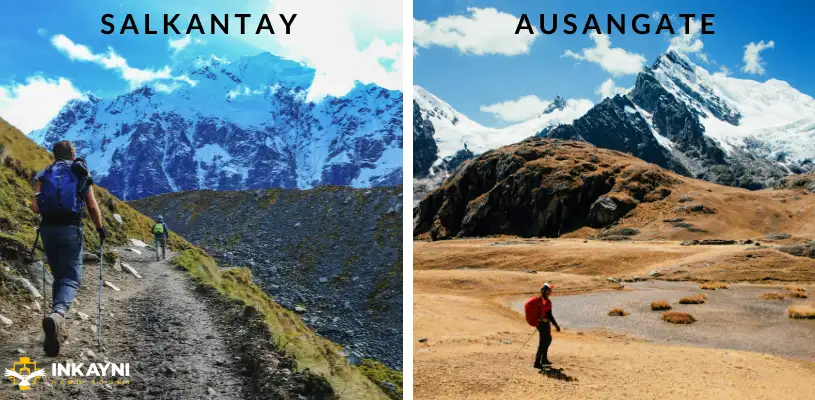
Salkantay Trek vs Ausangate Trek
AUSANGATE TREK VS CHOQUEQUIRAO TREK
It is undeniable that the Ausangate trek circuit is a challenging trek, mainly due to the altitude and cold conditions encountered on the route. The Choquequirao trek, although at a lower altitude, involves numerous daily climbs and descents, which can be more demanding for those who do not enjoy climbing.
Comparing both, the Ausangate Trek only differs from the Choquequirao Trek because of the altitude.
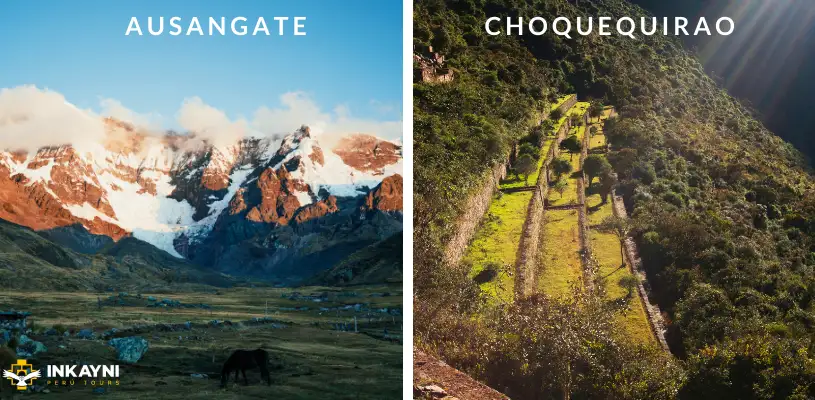
Ausangate Trek or Choquequirao Trek
AUSANGATE TREK VS RAINBOW MOUNTAIN
Rainbow Mountain is one of Cusco’s most popular destinations. I mean, numerous people travel or hire a full-day tour to Rainbow Mountain.
Despite its popularity, the Rainbow Mountain is part of the Ausangate Trek. The only difference is that by trekking the Ausangate Hike, you’ll get to Rainbow Mountain differently. In addition, Rainbow Mountain is one of the highest peaks on the Ausangate Trek.
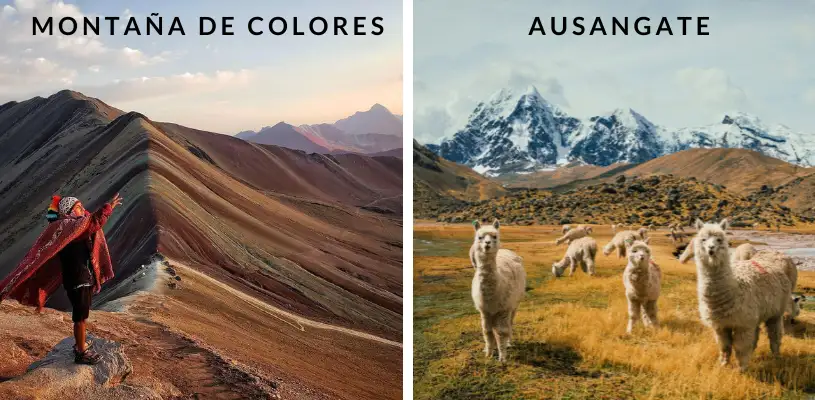
Rainbow Mountain vs Ausangate Trek
TREKKING THE AUSANGATE TREK HIRING AN AGENCY SERVICE OR ON YOUR OWN
| WITH AN AGENCY | ON YOUR OWN |
| They handle all necessary logistics, including transport, food, mules, etc. | Handle all the necessary logistics before starting off trekking. |
| They have itinerary options. | Make your own itinerary. |
| They offer the trek at their price, but it isn’t worth it sometimes. | You’ll spend more money organizing the trek. |
| A professional guide will be your companion whilst trekking. | Trekking on your own could be a problem in dangerous situations. |
PACKING LIST FOR THE AUSANGATE TREK
The weather in the Andes is unpredictable, so packing appropriate clothing and equipment will prepare you for any weather conditions you may encounter. We have provided the following packing list to give you an idea of what to bring:
CLOTHING
- Shirts and T-shirts
- Hiking trousers
- Waterproof clothing
- Underwear
- Non-slip socks
- Gloves
- Hat
- Sports bra
- Sunglasses
BACKPACK
- Backpack minimum 50 L
- Back Rain Cover
- Purification tablets
- Water bottle
- Trekking poles (optional).
- Sleeping tent (if trekking independently).
- Sleeping bag and sleeping mat (can be rented).
- Cooking equipment (if trekking independently).
TOILETRIES
- Toothbrush and toothpaste
- Microfiber towel
- Deodorant
- Soap
- Toilet paper
- Alcohol gel
- Sunscreen
AUSANGATE TREK ITINERARIES
RAINBOW MOUNTAIN TREK 02 DAYS: AUSANGATE, MOUNTAIN OF COLORS AND RED VALLEY
DAY 01: CUSCO – PAMPA ALCATAURY – ANANTA
- Distance: 14 km / 8.7 miles
- Starting altitude: 4,000 m / 13,123 ft ASL
- Hiking time: 6 hours
- Overnight: Ananta Camp
DAY 02: ANANTA – RAINBOW MOUNTAIN – RED VALLEY – CUSCO
- Distance: 18 km/ 11 miles
- Starting altitude: 4,930 m / 16,174 ft ASL.
- Hiking time: 6-7 hours.

Rainbow Mountain 2 days trek: Ausangate Mountain, Rainbow Mountain and Red Valley
| AUSANGATE MOUNTAIN + RAINBOW MOUNTAIN + RED VALLEY IN 2 DAYS | ||
| Vinicunca Trek | Day 1 | Day 2 |
| Trekking distance in Km | 14 km | 18 km |
| Trekking distance in mi | 8.7 mi | 11 mi |
| Altitude (m) | 4200 m – 5,000 m | 5,000 m – 5,200 m |
| Altitude (ft) | 13,779 ft – 16,404 ft | 16,404 ft – 17,060 ft |
| Trekking difficulty | Tough | Tough |
| Trekking time | 5 – 6 hours | 6 – 7 hours |
AUSANGATE TREK IN 05 DAYS
DAY 01: CUSCO – TINQUI – UPIS
- Distance: 12 km / 7.5 mi
- Starting altitude: 4,400 m / 4,435 ft ASL
- Overnight: Camp in Upis
DAY 02: UPIS – AUSANGATE – Q’OCHA LAKE
- Distance: 16.5 km / 10.25 mi
- Starting altitude: 4,600 m / 15,091 ft
- Overnight: Camp
DAY 03: AUSANGATE Q’OCHA LAGOON
- Distance: 11.75 km / 7.3 mi
- Starting altitude: 5,200 m / 17,060 ft
- Overnight: Camp in the Qampa Valley.
DAY 04: QOLQUE CRUZ SNOW-CAPPED MOUNTAIN – PACCHANTA
- Distance: 17 km / 10.6 mi
- Starting altitude: 5,000 m / 16,400 ft
- Overnight: Camp in Pacchanta
DAY 05: PACCHANTA- TINQUI – CUSCO
- Distance: 11, 25 km / 7 mi
- Starting altitude: 3,800 m / 12,467 ft
| Ausangate Trek 5D/4N | |||||
| Days | Day 1 | Day 2 | Day 3 | Day 4 | Day 5 |
| Trekking distance in Km | 12 km | 16.5 km | 11.7 km | 17 km | 11.3 km |
| Trekking distance in mi | 7.5 mi | 10.2 mi | 7.3 mi | 10.6 mi | 7 mi |
| Altitude (m) | 4,400 m | 4,600 m | 5,200 m | 5,000 m | 3,800 m |
| Altitude (ft) | 14,435 ft | 15,091 ft | 17,060 ft | 16,400 ft | 12,467 ft |
| Trekking difficulty | Tough | Tough | Challenging | Challenging | Tough |
| Trekking time | 5 – 6 hours | 6 – 7 hours | 6 – 7 hours | 6 – 7 hours | 4 – 5 hours |
FINALLY… IS AUSANGATE TREK DANGEROUS?
Yes, there are many risks when people trek some highland and rough trekking like the Ausangate Hike. Probably, most of the common risks are:
- The Ausangate Trails are made above 4,000 m / 13,123 ft and 5,000 m / 16,404 ft. It’s important to be well-acclimated before starting this trek and facing these huge altitudes.
- Weather conditions are unpredictable in the Andes, especially during the rainy season. Along the trek, there is a lot of rain, hail, and even snow. These factors make the trek dangerous and rough.
- When an emergency occurs, there are no nearby rescue points.
Also here are some tips for minimizing risks:
- Make sure you have prior training before the trek.
- Contracting with a travel agency that knows the route and local conditions is advisable.
- Bring proper trekking equipment.
- Make sure you have some pills and medicine on hand for different situations such as altitude sickness, painkillers or diarrhea.
- Prefer to trek in the dry season.
- We also advise you to always respect the mountains, following the philosophy of “leave no trace“, this means do not throw or leave waste while trekking, we must respect Mother Nature and preserve the landscape.
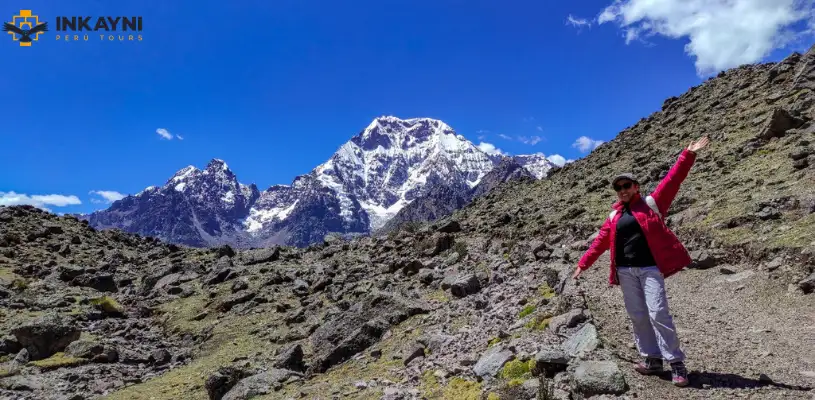
Ausangate Mountain in the background
Through challenging trails and beautiful glaciers, trekking the Ausangate trek is an unforgettable experience for nature lovers.
Taking part in this activity allows us to connect with nature and discover that we are all born adventurers inside.
So, dear traveller, the question is not whether it is dangerous or exciting. The question is: Are you ready to challenge your fears and embark on a route brimming with breathtaking scenery? The Ausangate trek awaits you.
Also, we answered one of the most common questions about the Ausangate Hike. I mean: Is Ausangate dangerous? Probably, the most accurate answer will be revealed once you hike the Ausangate Trek!
Dare to walk in the majestic Peruvian Andes and discover your greatness! Greetings! We are Inkayni Peru Tours, a travel agency with years of experience providing a safe and unique trip. Don’t take risks! And choose the most experienced Peruvian company.
👉𝗦𝗨𝗦𝗖𝗥𝗜𝗕𝗘 𝗢𝗨𝗥 𝗕𝗟𝗢𝗚 ▶ 👈
👉𝗦𝗨𝗦𝗖𝗥𝗜𝗕𝗘 𝗢𝗨𝗥 𝗧𝗜𝗞 𝗧𝗢𝗞 ▶ https://acortar.link/E4XQ8C 👈



